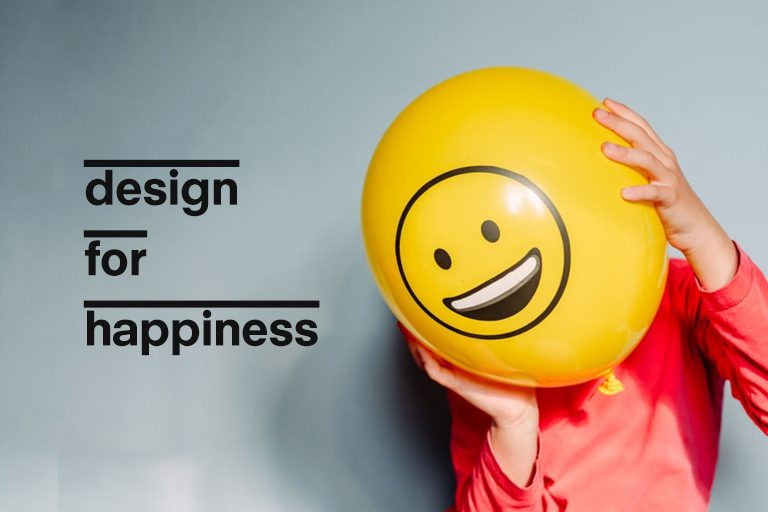How to design happiness – Strate
Let’s take a look at what happiness is before we talk about how to design it.
Did you know that happiness is a very recent concept in human history?
Only the last 250 years have been relatively safe and healthy enough for us to start considering our emotional quotient.
Happiness is a positive and pleasurable feeling. A person is happy when they feel pleased, glad, relieved, or satisfied about something. You can think of ‘happy’ as the polar opposite of ‘sadness.’
But, most people are not getting the difference between pleasure and happiness.
Pleasure is an instantaneous feeling of well-being or self-contentment.
Whereas happiness is more of an average of all the good moments of pleasure in your life around the time you are assessing it.
Using well-designed products will give you pleasure or cause you to feel good, as you will have an enjoyable experience while using them.
For example, if you ever used a cylindrical pencil, you would know the problem of this pencil rolling from the table and crashing on the ground.
Also Read: New-Age Design Philosophies of Global Brands
When using a hexagonal pencil, the flat surfaces are stopping the pencil from rolling. Thereby removing the threat of always having to worry about it at every move. This will generate a feel-good or a relief emotion in you.
We now have so many tools, objects, gadgets, and products that make our lives easier that we should be happier than ever, as most of our problems in life have been taken away and left us with enjoyable experiences.
Most design schools have trained student designers to make “experience design” and “user-centric design”.
It is mostly about understanding the problems surrounding a user while doing a specific task and trying to erase them from the equation to make the whole experience more enjoyable, hustle less, and easy to do.
This process mostly reshapes the world, reduces the threats, and solves our everyday problems.
For example, I am afraid of being late – alarm clock, no time to cook – microwave oven, don’t like to do the dishes – dish-washer, and don’t want to wait for a taxi – UBER.
Also Read: Applications of Color Theory By Top Brands
But humans quickly adapt to this new enhanced environment which becomes the new standard, and the “happiness” impact fades away quickly. Sometimes not even one week after buying the new product/solution.
I see a very close link with What Martin Sellingman dealt with in his TED speech about positive Psychology.
According to him, Psychology made a big gap after long studies and self-questioning; to its mission of making “miserable people less miserable (solve peoples’ problems), it added the task of making people happier.
The difference here is not very big; it mostly goes from looking at the glass half full to try to fill it, instead of just enjoying and making the best of what’s already inside. It did make an enormous difference in the whole approach and results of modern psychology.
I believe design needs to evolve in the same direction.
To design for happiness, and not just for well-being, we need to stop only solving people’s problems and start looking into what makes them happy.
Also Read: Global Impact of COVID on Design Ecosystem
Going from design against frustration to design towards happiness. With a BIG ‘H’.
This sounds like an exciting goal to reach. But how will designers get there?
How can designers create technologies, products, and services that enable individuals to participate in activities that bring them deep, long-lasting joy leading to happiness?
Of course, not everyone will be delighted with every activity.
We will react differently to different experiences according to our own stories, fears, and desires.
To help us, we can refer to Seligman’s three levels of happiness, which will allow us to group people more easily.
The first group: the ones who are looking for a good life.
At this level, people are looking to enhance their lives and are using their skills towards that. The feeling of joy/contentment, according to Sagmeister, comes from sensing no friction between you and the design on the way to reaching your goal. You could even spend more time than planned on this task/ work because you are having fun, being productive, or both.
Also Read: Coping With Pandemic Stress & Exam Pressure – Essential Tips
They are looking for a feeling of progression towards future goals; what motivates them is engagement.
The second group: the ones who are looking for the meaning of life.
They aim to be part of something bigger than them; happiness comes from a morally and valued behavior.
What motivates them is contribution.
The third group is the ones looking for a pleasant/ mindful life
This group aims to fulfill their life with positive emotions and instant pleasures one after the other.
What motivates them is addictive habits, rewards, and adrenaline rush.
Of course, none of us is 100% inside one of those groups only; our personalities are more complex and depend on our state of mind at specific timings.
You could be 20%/30%/50% in the morning and shift to 20%/70%/10% after watching a documentary on child labor or biodiversity collapse.
Also Read: Designer’s Tips to Overcome Creative Block
Yet, another study coming from Harvard, which started in 1968 and is still running over more than 2000 people, showcased that the actual deep core cement of happiness, the one thing that helps you get a HAPPY life, is social connections.
We are not referring here to the quantitative aspect of the connections but the qualitative part of them.
The more people have deep connections with others, the more they are happy and healthy.
This leads to 4 goals designers should aim at when designing for happiness:
- For the good life: Engaging and passionate experiences that make you grow/evolve
- For the meaningful life: Altruistic and meaningful experiences.
- For the pleasant life: Numerous enjoyable experiences giving the feeling that you’re being paid attention to
- For good social links: connecting or reconnecting people by enhancing human-to-human interactions.
As Pavliscak puts it:
Happiness, in short, is about amplifying human abilities, fostering new and deep connections, and challenging ourselves to grow while enjoying every tiny bit of life.
All of this is now possible because of the advancement of technology.
So, instead of focusing on making people’s lives easier, consider making their lives richer.
Richer in terms of experience, productivity, or achievement. Then aggressively optimize your product to assist them in just doing so.
If you accomplish that, you might create a product/solution that people love, trust, and return to without relying on any endorphin surge. That is the true face of design for happiness.
Our motto at Strate School of Design is: – Making the world +simple +just +beautiful
It can be further explained like this:
+ simple = Good life
+ Just = Meaningful life
+ beautiful = Pleasant life
And what do we get here? The answer is simple: focusing on Social Design.
That’s what we at Strate stand for!
Design for happiness by making the world simple, just, and beautiful.
Strate School of Design
Thomas DAL.



Want to Become a Designer ?
Strate is a unique design school that nurtures your talents as a designer by offering state-of-the art designing courses in Bangalore.
Join Strate